Do you have a question about the Kaco blueplanet 105 TL3 and is the answer not in the manual?
General safety instructions for device operation.
Information and download link for warranty conditions.
Provides information about the manual's purpose and warnings.
Defines symbols for hazards, electrical voltage, and earthing.
Details danger, warning, and caution levels for safety.
Describes the device as a transformerless PV inverter for grid feed-in.
Explains the device's role in converting DC to AC and feeding it to the grid.
Details the physical components and diagrams of the device.
Provides detailed electrical specifications for various KACO blueplanet models.
Lists the items included in the inverter package.
Provides instructions and cautions for safe transportation of the device.
Covers safety (fire/explosion) and environmental considerations for location selection.
Reiterates safety warnings for electrical connections and handling.
Explains how to safely open the device for installation.
Covers connecting AC leads, cable fittings, and grounding.
Details procedures to check for ground faults before connecting the PV generator.
Lists all available interfaces on the communication circuit board.
Safety warnings and prerequisites for starting up the device.
Explains different network segments and component connections.
First step in the installation wizard for selecting the interface language.
Notes on DC power supply requirement and configuration assistant.
Explains the meaning of the device's status LEDs during operation.
How to view daily, weekly, and monthly yield data through the web interface.
Explains how reactive power is used for voltage stability and control.
Shows operating ranges and maximum apparent power based on grid voltage.
Explains P set and P limit functions for managing infeed power.
Details immunity to voltage drops and spikes.
Setting limits on power change rates for plant load management.
Function to prevent grid impact by gradual increase of feed-in power.
Inspecting for external damage and noting operating status.
Instructions for cleaning the device housing and ventilation inlets.
Steps to disconnect AC cables safely.
Steps to disconnect DC cables safely.
General procedure for handling faults and safety warnings.
Safety warnings and steps for safely shutting down the device.
Procedures for safely uninstalling the device from its mount.
Lists certifications related to safety, EMC, and grid codes.
General safety instructions for device operation.
Information and download link for warranty conditions.
Provides information about the manual's purpose and warnings.
Defines symbols for hazards, electrical voltage, and earthing.
Details danger, warning, and caution levels for safety.
Describes the device as a transformerless PV inverter for grid feed-in.
Explains the device's role in converting DC to AC and feeding it to the grid.
Details the physical components and diagrams of the device.
Provides detailed electrical specifications for various KACO blueplanet models.
Lists the items included in the inverter package.
Provides instructions and cautions for safe transportation of the device.
Covers safety (fire/explosion) and environmental considerations for location selection.
Reiterates safety warnings for electrical connections and handling.
Explains how to safely open the device for installation.
Covers connecting AC leads, cable fittings, and grounding.
Details procedures to check for ground faults before connecting the PV generator.
Lists all available interfaces on the communication circuit board.
Safety warnings and prerequisites for starting up the device.
Explains different network segments and component connections.
First step in the installation wizard for selecting the interface language.
Notes on DC power supply requirement and configuration assistant.
Explains the meaning of the device's status LEDs during operation.
How to view daily, weekly, and monthly yield data through the web interface.
Explains how reactive power is used for voltage stability and control.
Shows operating ranges and maximum apparent power based on grid voltage.
Explains P set and P limit functions for managing infeed power.
Details immunity to voltage drops and spikes.
Setting limits on power change rates for plant load management.
Function to prevent grid impact by gradual increase of feed-in power.
Inspecting for external damage and noting operating status.
Instructions for cleaning the device housing and ventilation inlets.
Steps to disconnect AC cables safely.
Steps to disconnect DC cables safely.
General procedure for handling faults and safety warnings.
Safety warnings and steps for safely shutting down the device.
Procedures for safely uninstalling the device from its mount.
Lists certifications related to safety, EMC, and grid codes.
| Model | blueplanet 105 TL3 |
|---|---|
| Maximum Output Power | 105 kW |
| Max. apparent AC power | 105 kVA |
| Max. DC voltage | 1000 V |
| Maximum DC Input Voltage | 1000 V |
| Maximum Efficiency | 98.5% |
| Number of MPPTs | 1 |
| AC voltage range | 160 V to 280 V per phase |
| Nominal AC Frequency | 50 / 60 Hz |
| Weight | 95 kg |
| Protection Class | I |
| Operating Temperature Range | -25°C to +60°C |
| Maximum DC Input Power | 157.5 kW |
| MPP voltage range | 580 V to 850 V |
| MPPT Voltage Range | 580 V to 850 V |
| AC Nominal Voltage | 400 V |
| Communication Interfaces | Ethernet |
| Grid Connection | Three-phase |
| Cooling | Temperature-controlled fan cooling |
| Cooling Method | Temperature-controlled fan cooling |


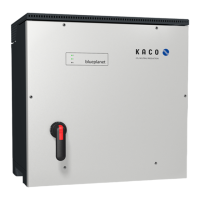


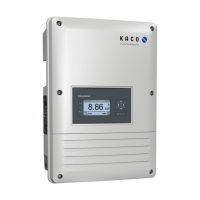
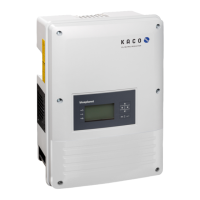
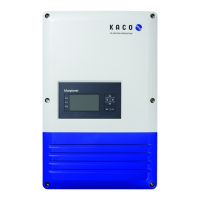


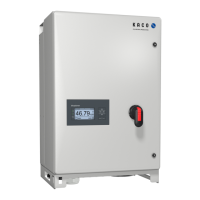

